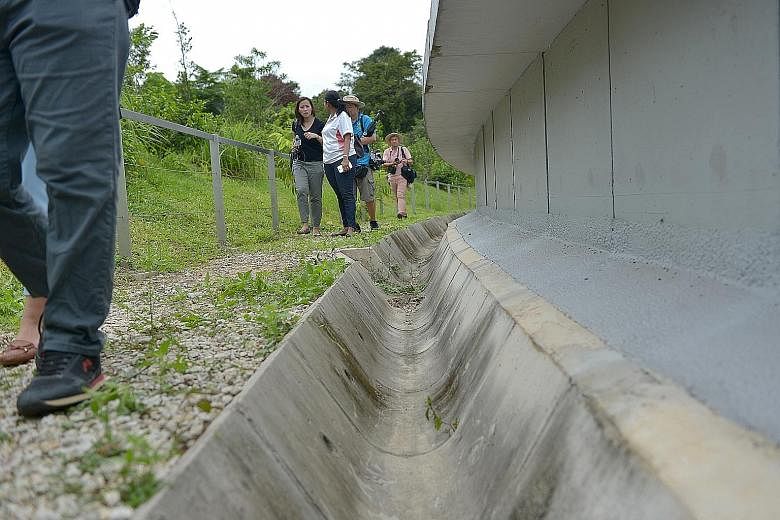SINGAPORE - A unique $16 million bridge reserved for animals such as civets and pangolins is opening its doors for the first time to another species - humans.
In the next two months, the National Parks Board (NParks) will conduct eight guided walks of the Eco-Link@BKE, South-east Asia's first ecological bridge. This will become a monthly affair from March.
The 62m bridge, which was completed in 2013, has so far been seen only from a distance by motorists on the Bukit Timah Expressway (BKE). It was built to reconnect the Bukit Timah Nature Reserve and Central Catchment Nature Reserve to allow wildlife in both areas to safely cross the BKE, which separated the two forests when it was built in 1986.
Access to it has been restricted so far to give plants time to grow and allow animals to get used to the bridge. NParks has since assessed that limited guided walks can be done with minimal disturbance.
During the media tour of the Eco-Link@BKE yesterday, Senior Minister of State for National Development Desmond Lee said it is important to strike a balance between protecting the area and helping the public understand the role the bridge plays in conservation.
"Unless we have public understanding and acceptance, it will not give us the impetus and community support to do even more," said Mr Lee.
During the guided walks, visitors will be able to learn more about the different kinds of animals that use the link as well as interesting facts about both nature reserves. To minimise disturbance, the number of visitors will be limited to 20 a tour and they will use only a small pathway at the side of the bridge.
Since 2013, NParks has worked with the community, including student groups, to carry out projects such as animal surveys, and plant more than 3,000 native flora on the bridge. Some of these can grow up to 15m and are meant to simulate the natural habitat of animals.
Plants are also grown at the edge of the bridge to create a buffer against noise and dust pollution so that animals will not be inhibited from using it.
Already, more than 15 species of mammals and birds have been spotted using the green corridor. They include the common palm civet and the critically endangered Sunda pangolin - all captured on cameras installed at the site.
While the ecological corridor is the region's first, it is not new in other parts of the world like Germany and the United States. Dr Shawn Lum, president of the Nature Society (Singapore), said that there had been initial concerns about whether animals would really use the bridge, given the traffic noise and the exposed environment.
-
Book slots for walks from Sunday
-
For the first time since its completion in 2013, the Eco-Link at Bukit Timah Expressway will be open to the public for guided walks.
Access to the ecological bridge had been restricted to allow vegetation to grow and wildlife to get used to the bridge without human disturbance.
The public can go for guided walks on the following dates:
Nov 21, Dec 5, Dec 19 and Jan 9
On each date, there will be two walks, lasting 11/2 hours and for 20 people each.
Slots are available on a first-come, first-served basis. Register at www.nparks.gov.sg/ecolink from Sunday at 10am.
Visitors are advised not to wear brightly coloured clothing as animals often interpret this as a sign of danger.
They are also advised to avoid using sunscreen or insect repellent as these may deter the animals from using the bridge.
Details of the monthly walks that are scheduled to start from March will be announced at a later date.
Carolyn Khew
"Wildlife is starting to come and the vegetation is starting to grow... So I'm delighted, and whatever initial concerns or worries that we had, luckily turned out not to have materialised," he said.
The results so far are encouraging, said Mr Wong Tuan Wah, NParks' director of conservation.
He highlighted how the number of pangolin road kills have gone down. According to NParks, there were no reports of pangolin road kills from April last year to last month. From 1994 to 2013, an average of about two pangolins died on the road each year.
When the vegetation grows even more, he hopes that other animals like the elusive banded leaf monkey will also make use of the bridge.




